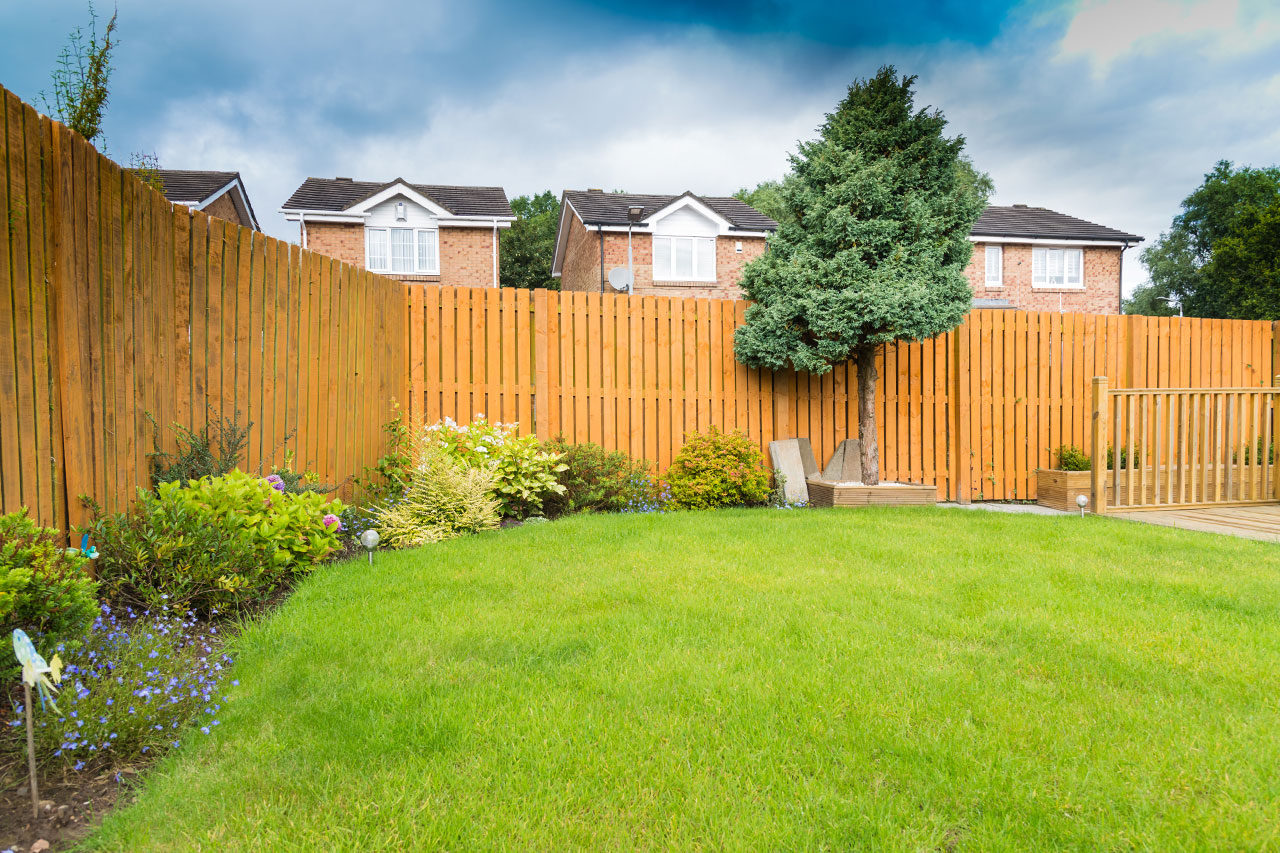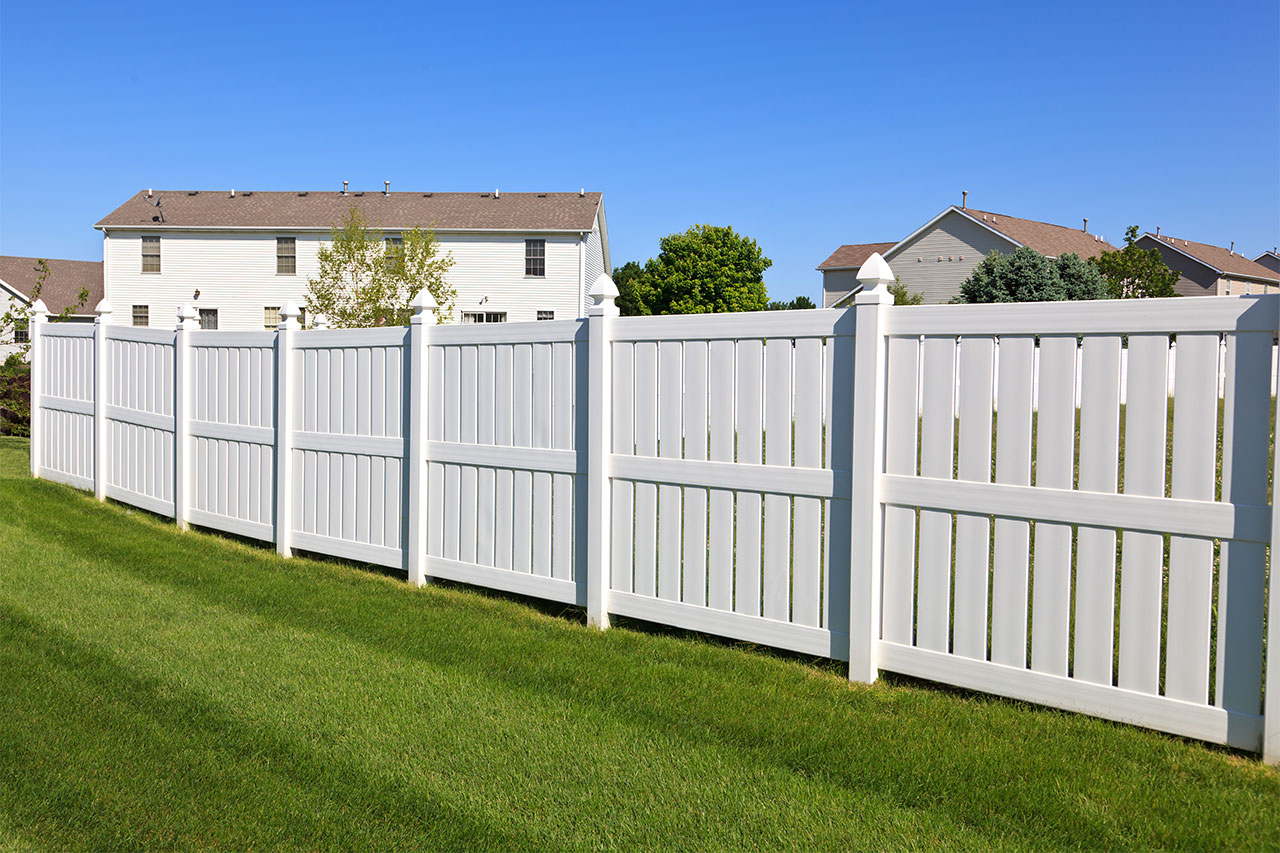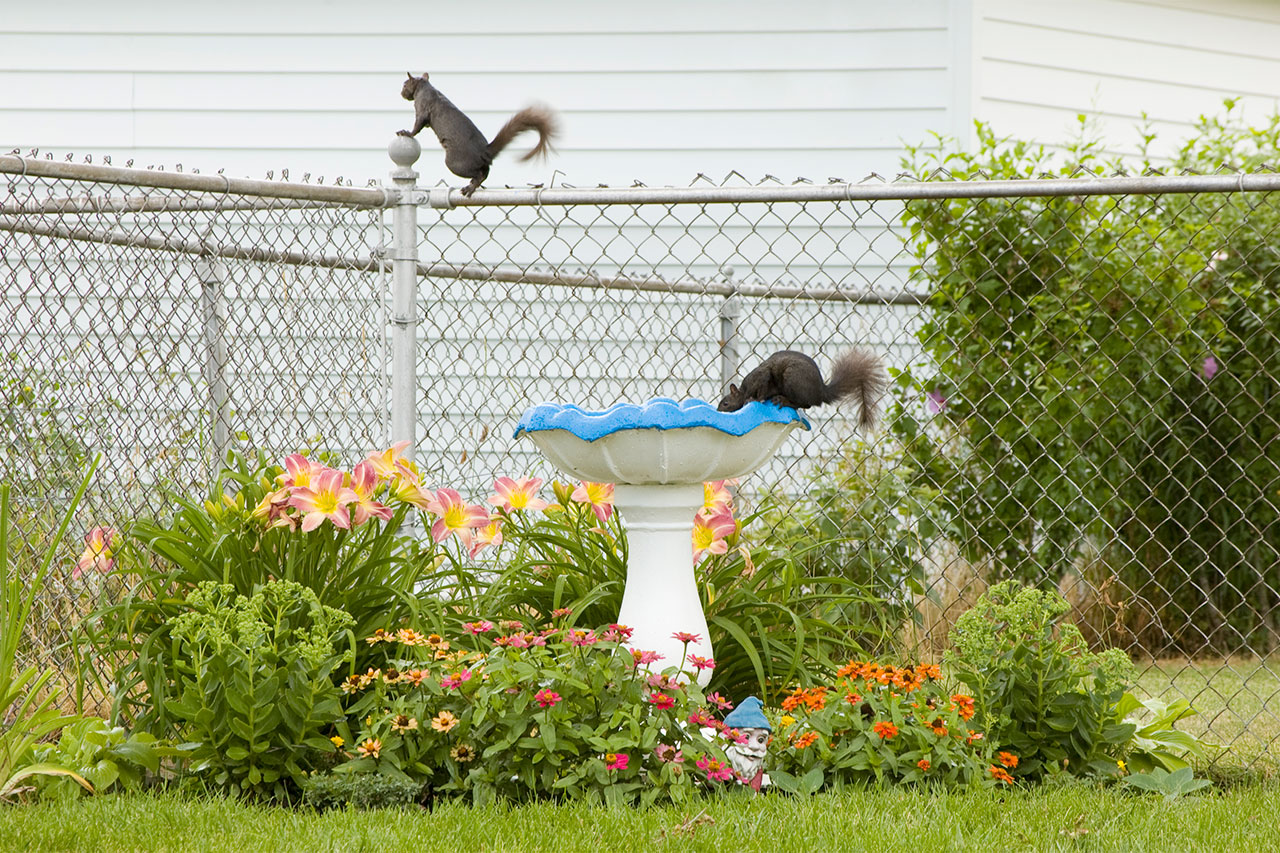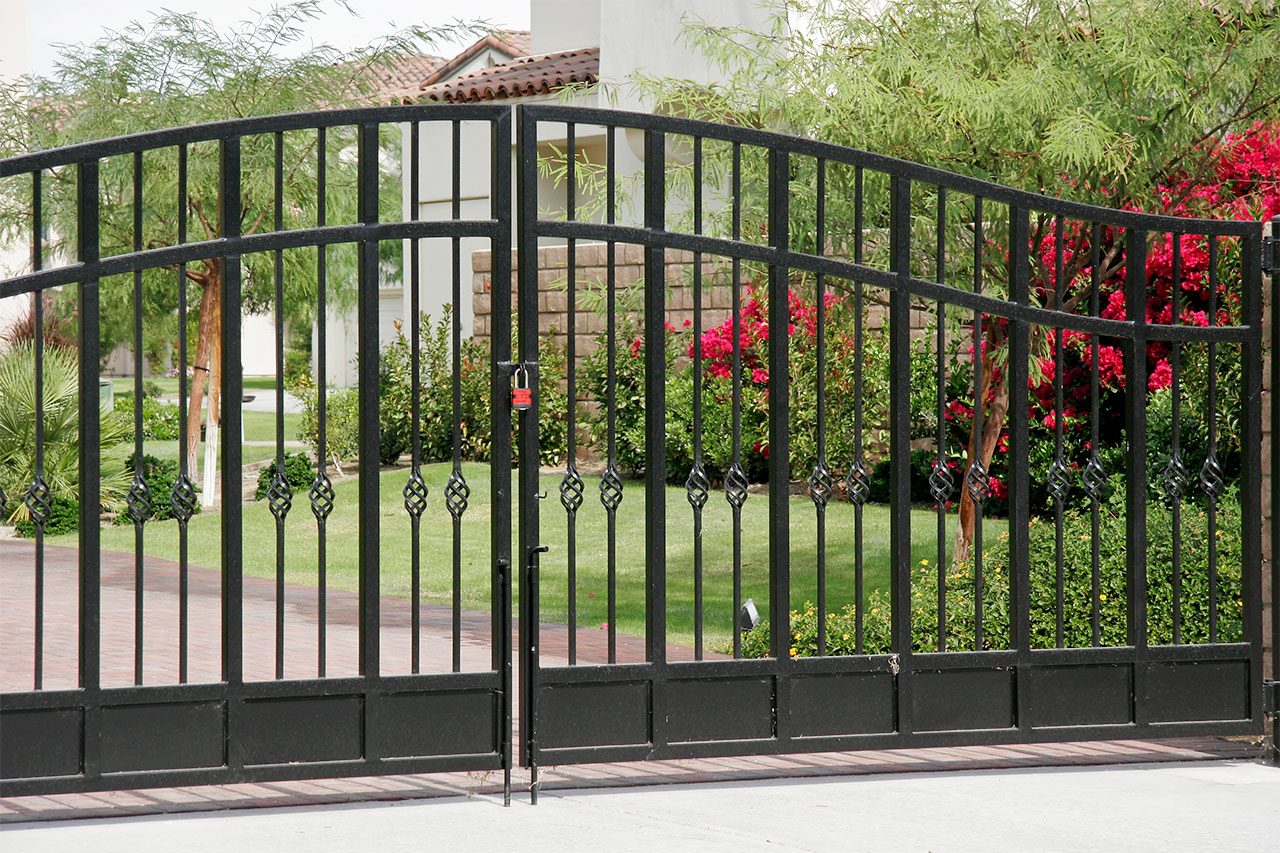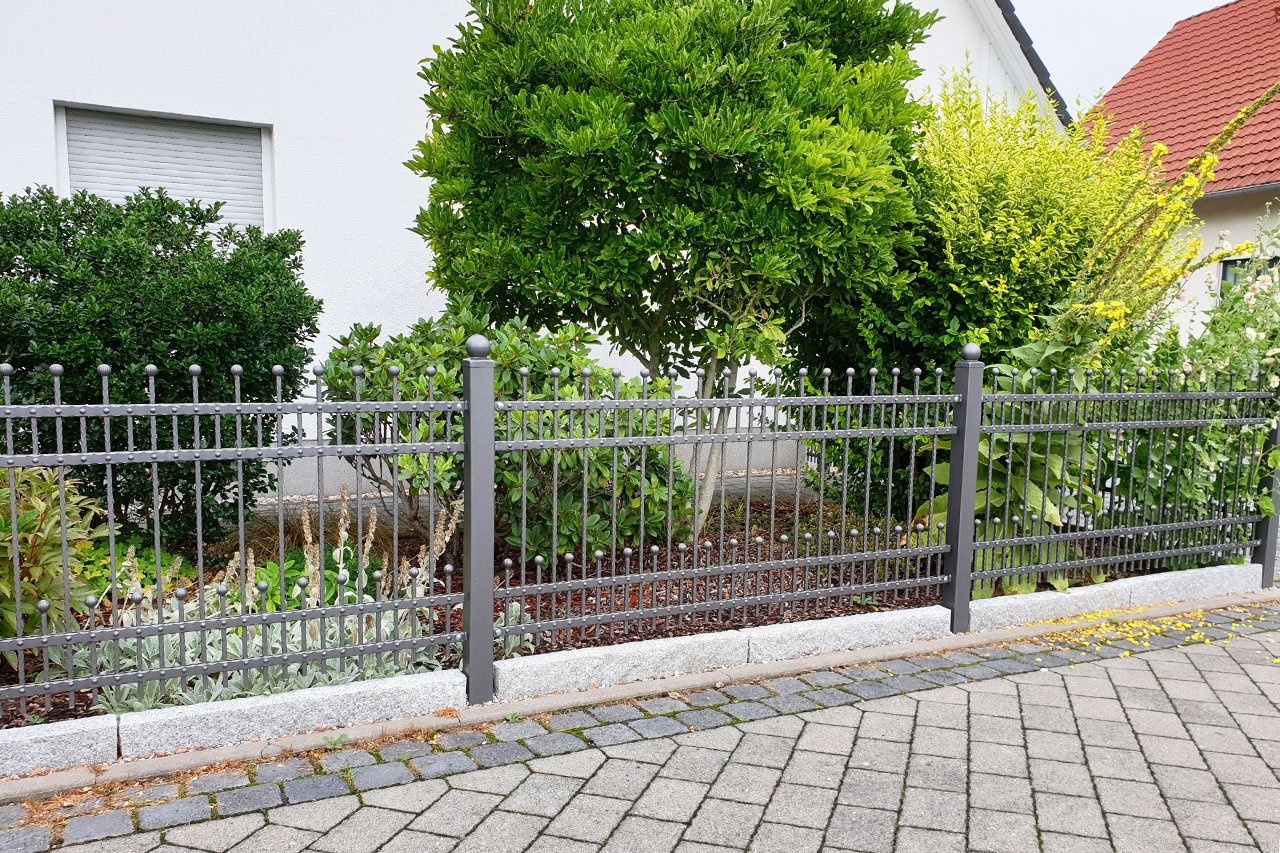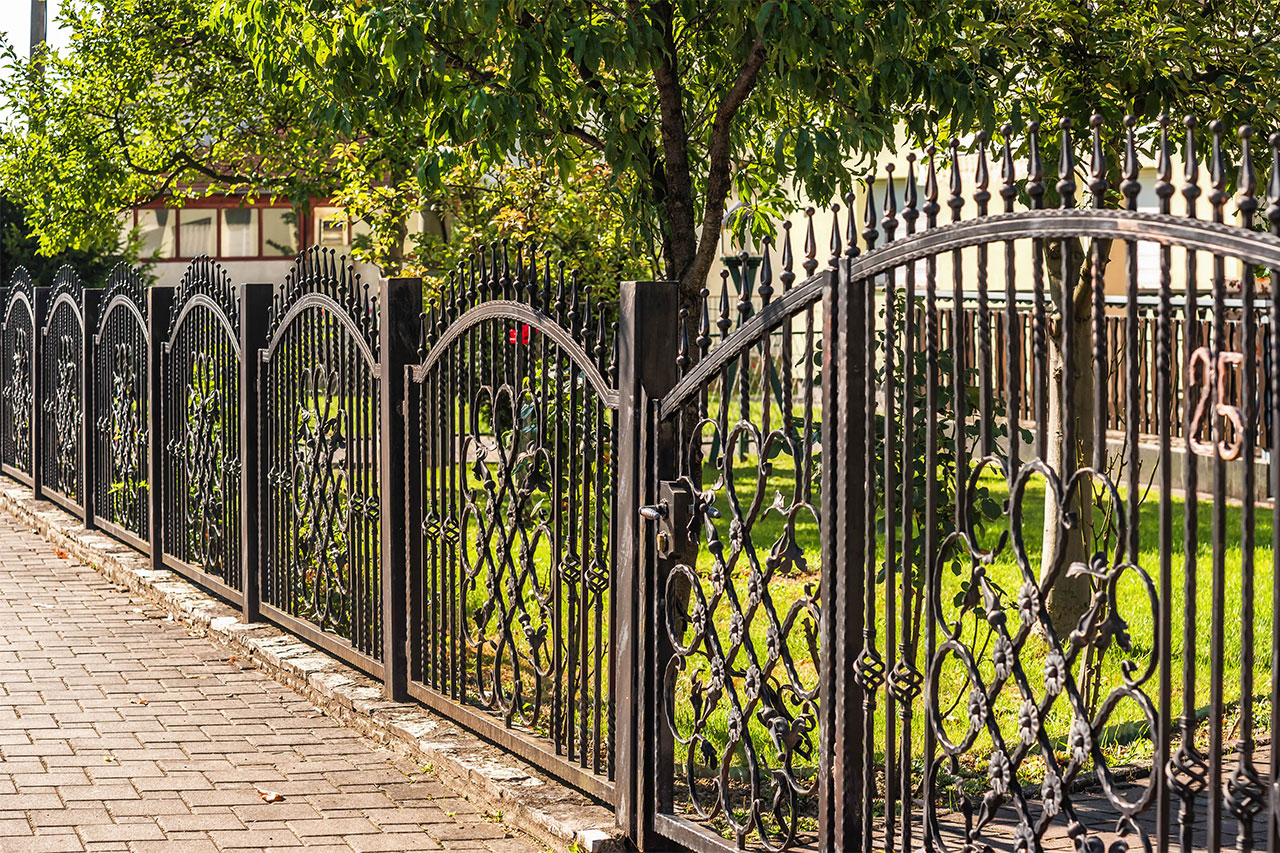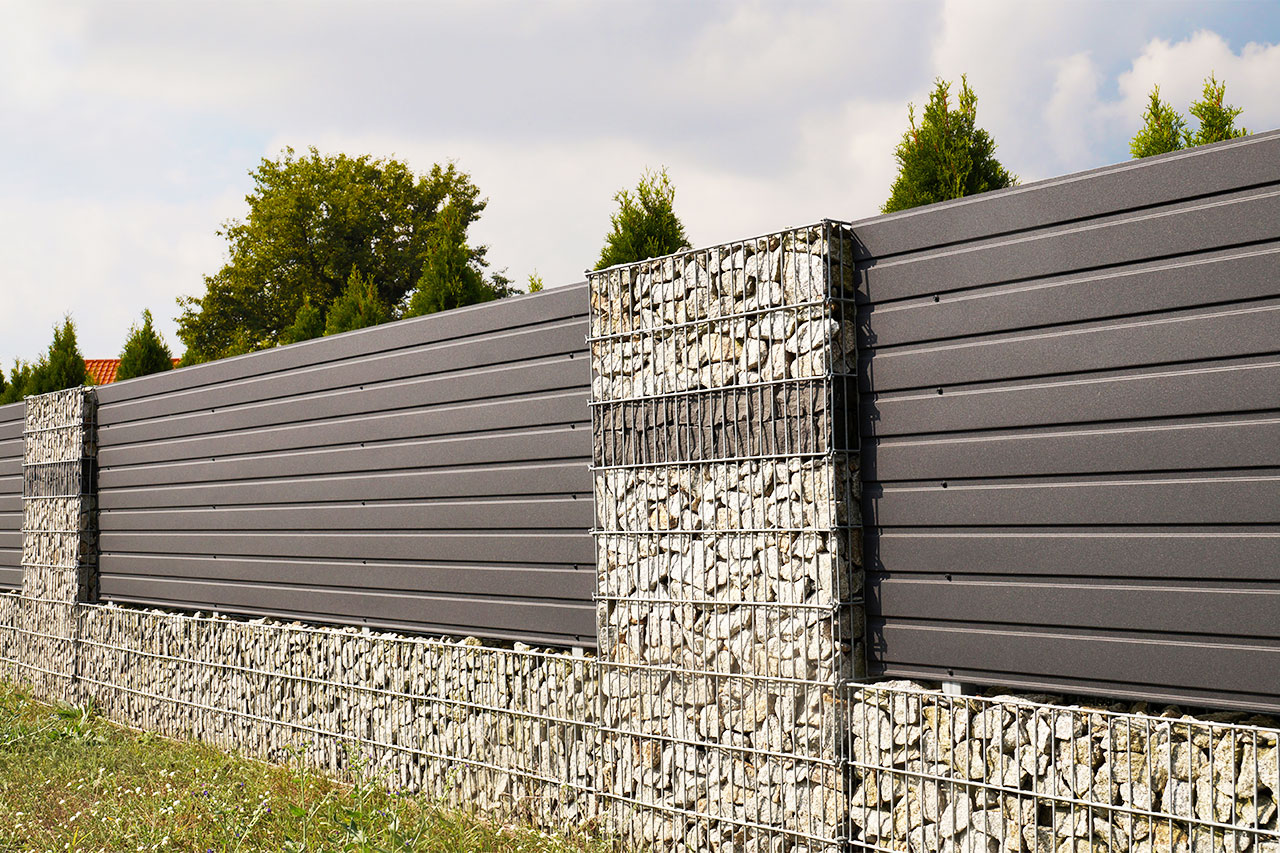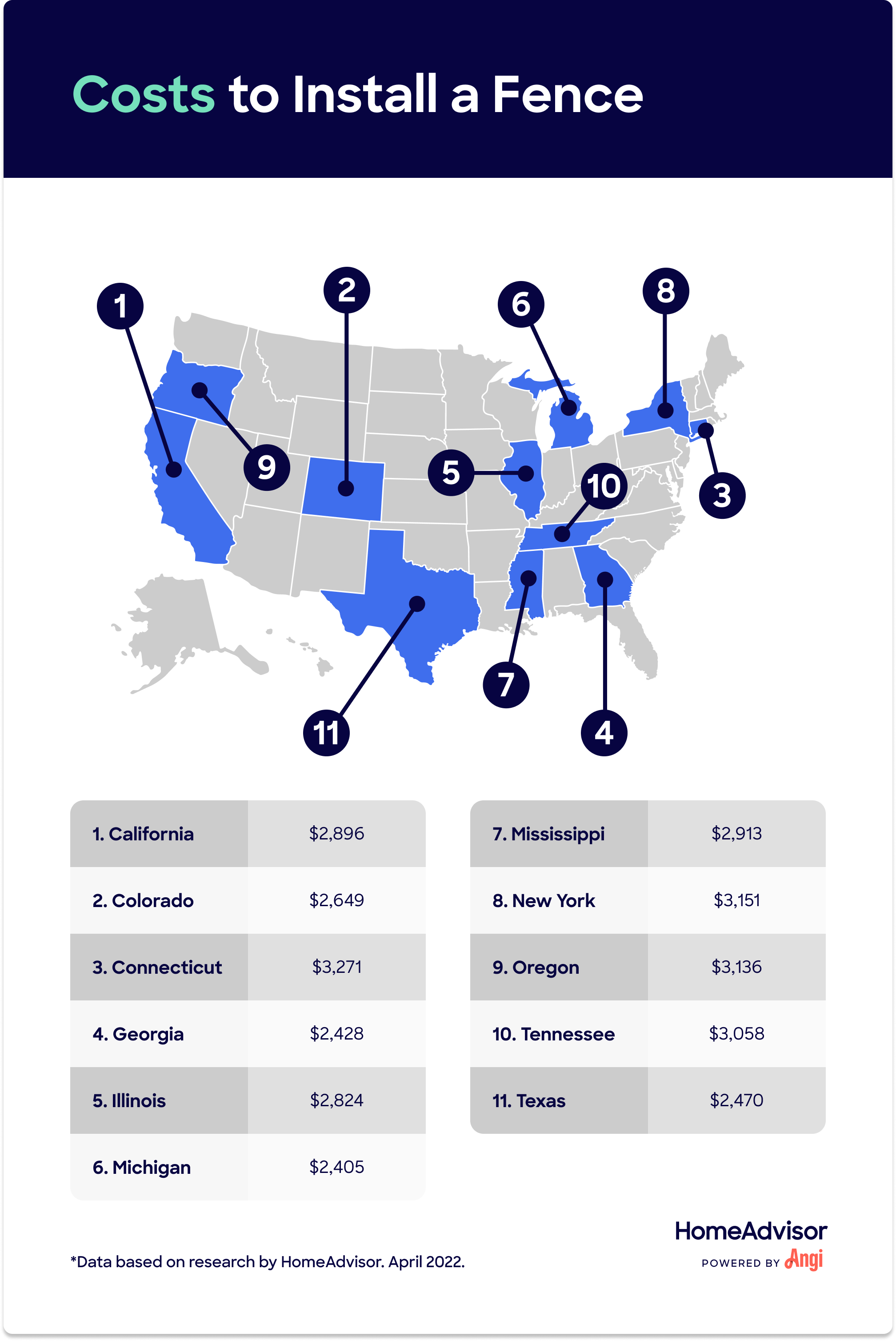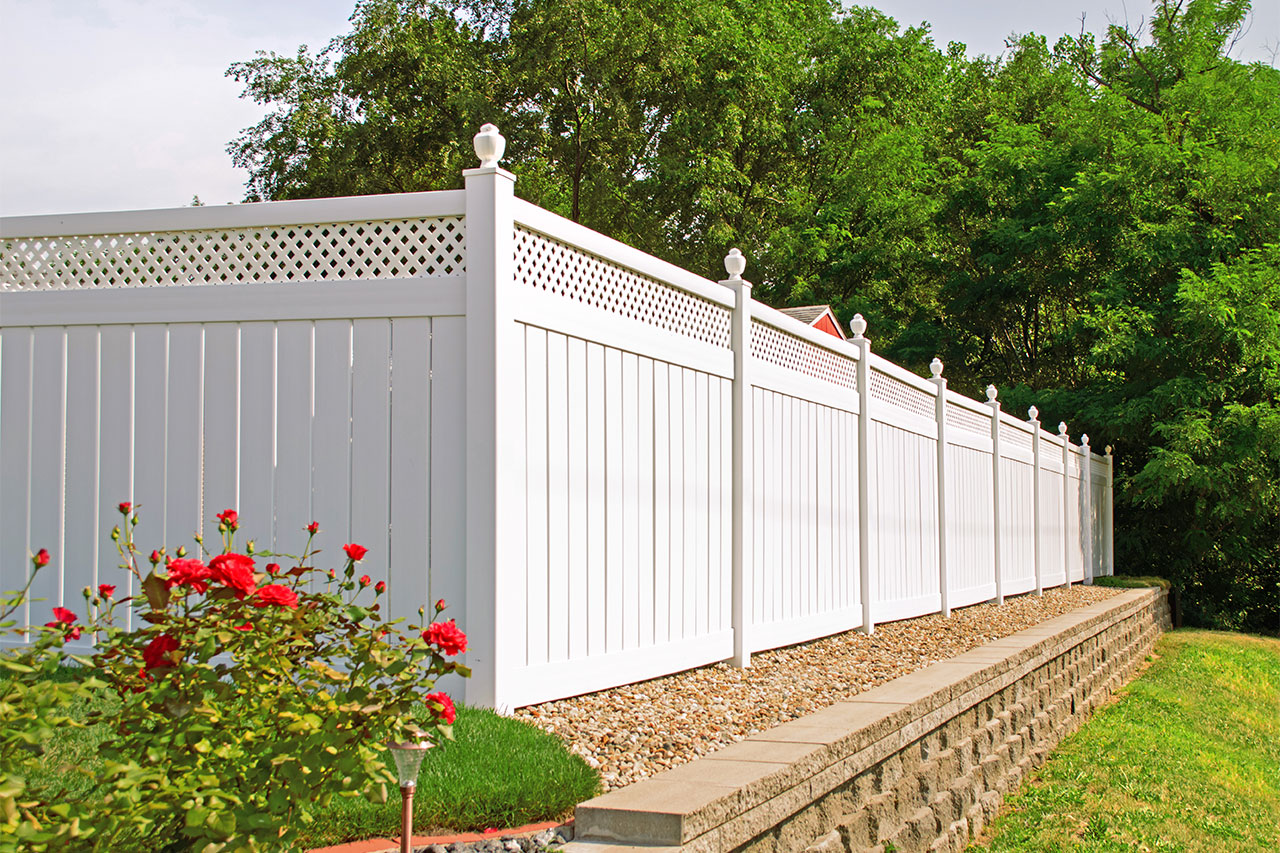How Much Does It Cost to Install a Fence?
Typical Range:
$1,855 - $4,744
Typical Range:
$1,855 - $4,744
Cost data is based on actual project costs as reported by 34,976 HomeAdvisor members. Embed this data
.
.
.
.
.
.
.
.
.
.
.
.
.
.
.
.
.
.
.
.
.
.
.
.
.
.
.
.
.
.
•
•
•
•
Updated September 27, 2022
Reviewed by Cati O'Keefe, Expert Home Building & Sustainability Contributor.A fence serves as a clear line separating your property from your neighbors and is a great way to make your home safer and add instant curb appeal. For a typical 150-foot fence, you can expect to pay $3,205 on average. The cost typically ranges between $1,855 and $4,744.
Let's calculate cost data for you. Where are you located?
Where are you located?
| National Average | $3,205 |
| Typical Range | $1,855 - $4,744 |
| Low End - High End | $425 - $13,700 |
Cost data is based on actual project costs as reported by 34,976 HomeAdvisor members.
Traditionally, a fence runs the perimeter of a property, so how much you need is determined by how big your property is. In metropolitan areas or new developments, the average lot size is about 1/5 acre or 8,712 square feet. This size lot requires about 150 linear feet of fencing.
To get a more precise estimate for the fence size and materials required for your yard, do the following:
Research code restrictions like height, post spacing, and allowable fence types for your area.
Find your property lines, utility lines, and where you’d like the fence to be located.
Measure the distance where the fence will be.
Divide that measurement by the required post spacing, then add two. This is how many posts you’ll need.
Multiply that number by two or three for rails.
Divide the total length by the width of your pickets for how much wood you need. Or add up the number of panels you’ll need for vinyl.
While there are multiple fencing materials to choose from, consider matching style, height, and material with your neighbors to maintain property values. Otherwise, most homeowners opt for wood or vinyl fencing, two affordable and long-lasting options. In addition, chain-link, aluminum, steel, wrought iron, and composite fencing are popular fence types.
| Fence Material | Average Price Range per Linear Foot |
|---|---|
| Wood | $17 – $45 |
| Vinyl | $10 – $40 |
| Chain-link | $15 – $30 |
| Aluminum | $17 – $90 |
| Steel | $17 – $90 |
| Wrought iron | $30 – $55+ |
| Composite | $11 – $45 |
Western red cedar, Douglas fir, pressure-treated wood, and redwood are the most common wood used for fences. Wood fences cost on average $17 to $45 per linear foot. The average 150-foot wood fence will cost $2,950 and range between $1,705 and $4,200.
Wood fences are popular because they offer privacy, can easily be painted, and fit in with the aesthetics of most neighborhoods. It has a limited life span—usually between five and 10 years—and must be painted and maintained regularly to prevent fungus and dry rot.
The price is directly influenced by which type of wood you choose. For materials alone, a basic plank, such as pine, costs as little as $1.50. Cedar can cost $7 to $15 per linear foot. Redwood can cost $17.50 per piece.
If these are more than your budget can handle, there are less expensive options to consider.
Vinyl fencing costs between $10 and $40 per linear foot. You can expect to pay $3,820 on average for a 150-foot fence, or between $2,240 and $5,480.
Vinyl fencing is popular because it's virtually maintenance-free, has multiple color options, and is easy to install and clean. However, it isn't suitable for extreme climates, and comes with a considerable upfront cost for materials. Installing pre-built fence panels instead of having it built from scratch could significantly reduce costs. Vinyl fences are also made of plastic, so some homeowners dislike the environmental impact.
If you’re still debating between wood and vinyl fencing, read more about the pros and cons of vinyl versus wood fences.
Chain-link fences cost about $15 to $30 per linear foot. You can expect to pay $2,200 on average for the typical 150-foot fence, or between $1,290 and $3,370. Chain-link is a basic, affordable option. It has a long life span with minimal maintenance and is one of the easiest materials to install if you're a DIY-er. However, chain-link fences are see-through so they don't make good privacy fences.
Metallic-coated chain-link fencing is the most popular because it's the most economical. A more attractive option is color-coated chain-link fencing, but color-coating increases the cost quickly. For example, black chain-link fencing costs $5 to $25 per foot for materials.
Aluminum fencing costs $17 to $90 per linear foot. The national average to install an aluminum fence is about $3,970 for a 150-foot fence. Most homeowners pay between $2,240 and $5,720.
Aluminum fences are popular because they require little maintenance, are corrosion- and rust-resistant, and offer a modern aesthetic and a long life span. However, installation is expensive.
Steel fencing costs $17 to $90 per linear foot. The national average to install a steel fence is about $3,970. Most homeowners pay between $2,240 and $5,720.
Steel fencing is popular because it allows the homeowner to simulate wrought iron for a fraction of the price. It's also easy to install for most DIY-ers and is low maintenance. However, it's also prone to scratches and rust.
Wrought iron fences cost $30 to $55 or more per linear foot. This is considered one of the most attractive fencing materials and can boost your home's curb appeal. However, it can be prone to rust, dents easily, and is expensive to install and maintain. Like chain-link, some gaps can easily be peered through.
"Composite fencing is an eco-friendly alternative to vinyl that costs about the same," says Cati O'Keefe, Expert Home Building & Sustainability Contributor. "Many composite products are made from recycled materials, including reclaimed wood, sawdust, and recycled plastic."
Composite fencing costs $11 to $45 per linear foot. The average 150-foot fence costs $4,200, and most homeowners pay between $1,650 to $6,750. They're typically made of plastic and wood to create an eco-friendly alternative.
The cost to install a fence is affected by several factors, like the following:
Fence size
Fence height
Labor cost
Fence installation by state
Fence posts
We’ll discuss each of these in detail below.
Fencing costs on average $13 to $50 per linear foot, including professional installation and materials. The average residential fence height ranges from 4 feet to 6 feet, depending on the fence material and placement. That being said, fences can be anywhere from 3 feet to 12 feet tall.
The fence height affects the price. A 3-foot high fence is standard for most front yards, while a 6-foot high fence is typical for most backyards. Increasing your fence to 8 feet high can add 25% to 35% to your cost. You'll want to check with your local code enforcement agency or homeowners association about restrictions on fence heights as well. If you're fencing in a pool, locks may also play a factor if you need to pass code.
Labor will make up about 50% of the total cost for an installed fence. For fence contractors, labor will run $30 to $80 per hour, with the average 150- to 200-linear foot fence taking a professional installer 20 to 35 hours to complete. Labor costs will differ around the country.
Installation prices vary across the U.S., with rough terrain and hard-to-reach locations increasing the overall price.
The posts are set in the ground and act as the support for the fence. For just the post and concrete, you'll spend $5 to $150 per post. Post spacing is usually 4, 6, or 8 feet apart. Your local building code will dictate spacing, burial depth, and amount of concrete needed.
If you need to install posts below the frost line to avoid upheavals, this can increase the post's length and the amount of concrete needed. Your local code will also dictate whether a corner post or all posts require concrete setting.
When planning your project, there are a few other factors to consider, like the cost for permits and surveys, land condition, removing your old fence, what kind of gate(s) you'll need, and the fence style.
On average, fence building permits cost $20 to $60 if required. To find out if you need a permit, contact your local municipality. It's also worth paying the extra $400 to $750 for the cost of a land surveyor to measure your land. If you measure improperly, you may unintentionally build on land that’s not yours, leading to legal issues if there's a dispute.
Flat land with soft soil is the best for installing a fence. Expect higher fees if the land is sloped because installation is more complex and time-consuming. If you need it, lawn regrading costs about $1,000 to $3,200.
You'll have to pay to remove your old fence if you're replacing it. Removal can run between $3 and $5 per linear foot or $450 to $750 for a 150-foot length. Removing the old fence yourself can save you money.
Your new fence will likely need a gate, and it can run anywhere from $150 to $600 or more for drive-through varieties. Expect to pay an additional $100 to $250 for labor.
The style you select will determine your fence costs. For example, wood picket fences require more time and care to install correctly. Decorative features like a lattice top will also impact overall installation costs.
Installing a fence can make for a great DIY project if you have 30 to 50 hours to spend on it. It helps to have little experience tracking down building codes and permits and using basic tools like a shovel, hammer, drill, and circular saw. You can rent tools like a post-hole digger or auger from local hardware stores. You can also save time by using prefab fencing panels instead of installing your fencing board by board.
If you don't want to take on the entire project, there are multiple ways you can share the work with a fencing pro near you to save some money. Shop for materials to avoid paying your pro marked-up prices. Hire a contractor to dig post holes, erect posts, and set them in concrete, then take on the last step yourself and nail planks in place with a rented nail gun.
Of course, there are always some advantages to working with a pro. While they’ll charge a markup for materials, they sometimes receive discounts that could make the entire process more affordable for you. And most pros warranty their work, while any DIY mistakes may increase your cost.
A 150-linear foot fence will take about 20 hours to complete.If you’re a DIY-er, it could double that time. You must also consider your fence’s length, height, materials, and terrain. If, for example, you need to install a fence around the perimeter of your half-acre home that sits on challenging terrain, you should anticipate several days or longer.
Many pros and DIYers consider wood panels, steel, aluminum, and vinyl fences among the easiest to install. While no two fencing installation projects are the same, these types of fencing present the fewest challenges to the determined DIYer. Like all fencing installation projects, however, terrain plays a significant role in how easy installation can be.
DIY fence installation will save you quite a bit. However, if you make a costly mistake and end up hiring a professional fence installer, you’ll pay more than you would’ve in the first place. If you want to reduce the chance of error and expedite the process, it’s always best to hire a professional. They can also help you determine which fence type or brand works best for your budget.
Different fence types have different lifespans. Vinyl fences last 20 to 30 years, while aluminum fences can last up to 50 years with little maintenance. However, wood fences last between five and 10 years, while some types of wood may stretch to 20 or more with diligent care and maintenance. Wrought iron has the longest lifespan and can last many lifetimes with proper upkeep.
Yes, fences can increase your home’s value. However, the ROI depends on the type of fence you choose and how well you maintain it before you list your home for sale. Fences can impart up to a 70% ROI but, again, it depends on the type of fence, your home’s condition, your location, and the market as a whole. Broadly, though, expect a fence to add value to your property.
